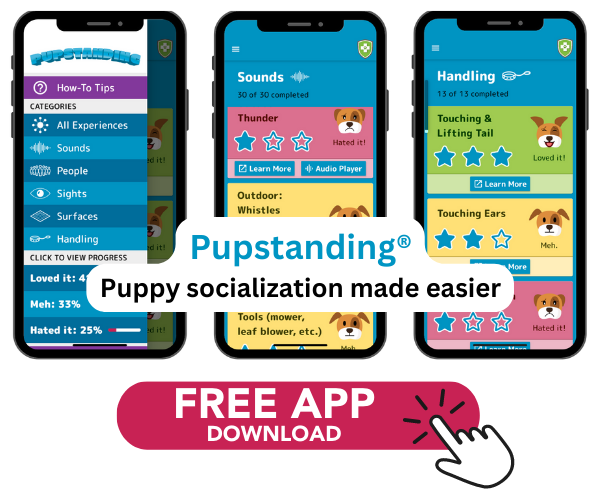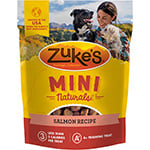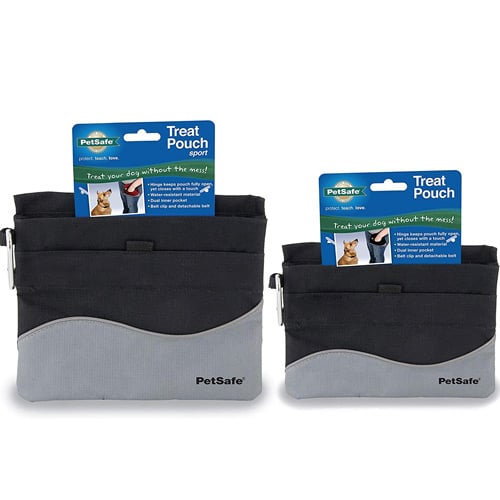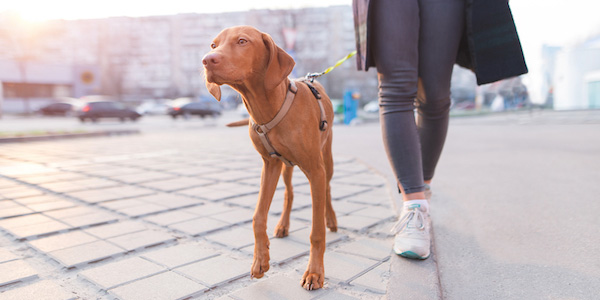 Is your puppy ready to start exploring beyond the backyard? Expanding your puppy’s socialization beyond your home and their puppy classes requires a balancing act between needed environmental exposure and needed vaccinations.
Is your puppy ready to start exploring beyond the backyard? Expanding your puppy’s socialization beyond your home and their puppy classes requires a balancing act between needed environmental exposure and needed vaccinations.
Taking precautions and limiting where you go on puppy adventures will help minimize the risk of disease while still allowing for crucial exposure needed during a puppy’s imprint period (which ends around 14 to 16 weeks of age).
As you’ll read below, these walks aren’t about direct interaction with people and other animals, but about positive exposure to these things from a distance. You’ll want to carefully choose where you take your puppy on socialization adventures.
Avoid areas where other dogs frequent or go to the bathroom (such as pet stores or near dog parks), and don’t allow your puppy to drink from puddles. You can further protect your puppy by taking them out for these walks in a stroller or in a backpack rather than on a leash. Speak with your veterinarian to ensure that your puppy is on track for their vaccinations, and what risks are prevalent in your area to be mindful of.
Why Puppy Socialization is Important
“Because the first three months are the period when sociability outweighs fear, this is the primary window of opportunity for puppies to adapt to new people, animals, and experiences. Incomplete or improper socialization during this important time can increase the risk of behavioral problems later in life including fear, avoidance, and/or aggression.
Behavioral problems are the greatest threat to the owner-dog bond. In fact, behavioral problems are the number one cause of relinquishment to shelters. Behavioral issues, not infectious diseases, are the number one cause of death for dogs under three years of age.
While puppies’ immune systems are still developing during these early months, the combination of maternal immunity, primary vaccination, and appropriate care makes the risk of infection relatively small compared to the chance of death from a behavior problem.” Source: AVSAB
With proper precautionary planning, you can balance socialization with your puppy’s vaccination schedule. To learn more about socialization and vaccinations, read the American Veterinary Society of Animal Behavior’s position statement.
Socialization adventure walks are perfect for acclimation to the different things your puppy will see throughout their lives while out and about with you, and also provide much-needed environmental enrichment. And, these walks build a strong and trusting relationship between you and your puppy!
What is a Puppy Socialization Adventure Walk?
These kinds of walks are a bit different than a normal walk you might take to give your dog some physical exercise. Socialization walks with your puppy focus on proactive exposure — creating neutral and positive associations with different people, places, and things.
Socializing your puppy isn't just about meeting and interacting with people and other dogs — in fact, proper socialization focuses on exposure, not always up close (and often overwhelming) interaction.
A puppy socialization adventure walk is a relaxed exploration of different environments, getting to see other people and animals from a distance, and an opportunity to start building very simple (but very important) training foundations. Introducing cues such as name recognition and hand targeting will set you up for success in future leash walking manners.
The goal for a socialization walk is to create calm and positive associations with different things your puppy sees, smells, hears, and otherwise experiences. This helps prevent fear, anxiety, or reactivity towards these things in the future.
Watch Preventive Vet puppy Finnegan, a Portuguese Water Dog, taking a few socialization walks through his neighborhood in this video. Can you identify all the different things he's being proactively exposed to?
Safety Tip: Wipe your puppy's paws with a disinfectant wipe to remove any trace of fecal matter before they lick their paws or contaminate your home or car. It's even better to have your pup wear booties, like these easy-to-use Pawz Booties. They're reuseable and disposable!
Learn how to acclimate your puppy to wearing boots here.
Finnegan experienced so much while out and about — and many things we can't even count since we lack his sense of smell! Here are some of the things I noticed:
Sights: Shadows from railings, dogs behind a fence, dogs on leash, baby stroller, a child playing on the jungle gym, a cat in the window, a man in a hat, fire hydrant, yellow color contrasts for crosswalks
Sounds: Barking, yard tools, airplanes, trucks, bicycle bells
Surfaces: Asphalt, grass, metal manhole cover, landscaping bark, raised sidewalk bumps
Those are just a few examples of the different things you want to proactively expose your puppy to while they're in their crucial imprint period (which lasts between approximately 7 weeks to 16 weeks of age).
Check out our free interactive Pupstanding App to see all of our suggestions for puppy socialization experiences and keep track of what your puppy has done:
Tips for Puppy Socialization Walks
Manage Distance
If your puppy seems unsure of something they see, help them feel more comfortable by allowing them to back away and observe from a distance. Never force a puppy to approach something they show uncertainty towards. Praise them for showing any curiosity — you can offer them a treat after they take a step towards something, but be careful not to use the treat to bribe them closer to the person or thing they are scared of.
Now, if your puppy has the opposite problem and wants to drag you towards something in excitement, adding distance is also going to help you! Back away as far as is needed to be able to get your puppy's attention. Use name recognition to build better focus around the distraction, and then slowly work closer and closer to the thing they want (as long as it's safe and appropriate).
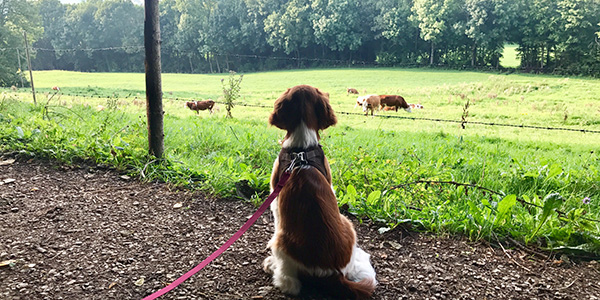
Stay Calm and Positive
Your puppy takes cues from your reactions to certain things that happen around them. Keep your energy calm and positive, even if something startles you. These socialization adventure walks are really working your puppy's reaction to sudden environmental changes, which is important for building resiliency and coping skills.
Finnegan's owner does a great job in keeping her tone of voice happy and at a lower volume level to encourage calm responses. Check out his adventure walk here.
Always Have Rewards Available
Stock up on some yummy training treats and always wear a treat bag while out on walks with your puppy. This way you're prepared to reward them for any behavior you like! The more a puppy is rewarded for certain behaviors, the more likely they are to choose to do those in the future. If your puppy is motivated by toys, bring a toy along on your walk to reward them for good behavior.
You may go through a lot of treats on your walk, so keeping them small and low-cal is ideal. I like to have a puppy's regular kibble mixed in with some higher-value treats (such as the Zuke's treats above) when I take them on adventure walks.
Whenever they glance back at me, they get a "Yes!" and I offer them one. It's amazing to see how quickly they figure out this game — plus it's building focus and polite leash walking at the same time!
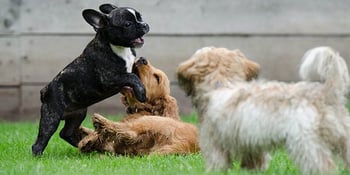 Socialization for Puppies Younger than 12 Weeks Old
Socialization for Puppies Younger than 12 Weeks Old
For puppies that are still too young and haven't received needed vaccinations for exploration, you can do a puppy socialization picnic instead! Just set up a nice area in your front yard or patio to sit with your puppy, keep them on a leash, and watch the world go by.
Give lots of calm praise when they notice something new and different, and offer them a treat if they notice a person or dog walking past and don't bark.
Many dog trainers offer young puppy socialization classes for those pups that are still too young to get outside and explore. Read more in our article on "How to Choose the Right Puppy Class" to make sure you find the perfect class for you and your puppy.
All Dogs Can Benefit from Socialization Adventure Walks
These kinds of walks are also beneficial for dogs who might have missed out on socialization when they were younger, or dogs who suffer from generalized anxiety. However, in order to be effective and not cause more fear or anxiety from developing, it's imperative you work closely with a certified dog trainer and learn how to read your dog's body language.
PRO TIP: Whether you’re going on an adventure walk with a young puppy, under socialized adult dog, or anxious and reactive dog, it’s all about making sure your dog has a great experience.
This means you should always aim to keep your pup “under threshold” — far enough away from people, animals, or things that might overwhelm them. This gives you the ability to create positive associations with particular things. A certified dog trainer can help you create a personalized training plan and set you up for success.
For senior dogs, a more relaxed adventure walk (such as the Sniffari Walk) is a great way to provide low-impact physical exercise and work their brain by letting them sniff and explore, even if you aren't focusing on the socialization aspect.
Puppy Socialization Adventure Walks are a perfect opportunity to explore with your new puppy and practice positive socialization and exposure. So get out there and have fun! We'd love to hear how it goes with your puppy — share with us in the comments below what your puppy has experienced on your latest Socialization Adventure Walks!



